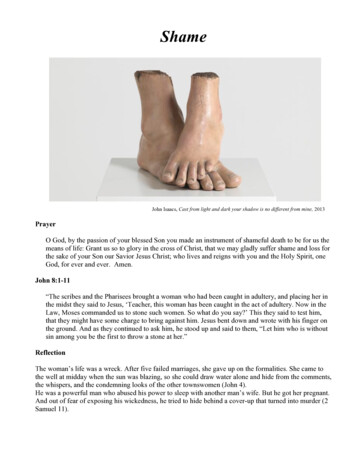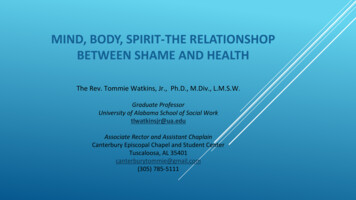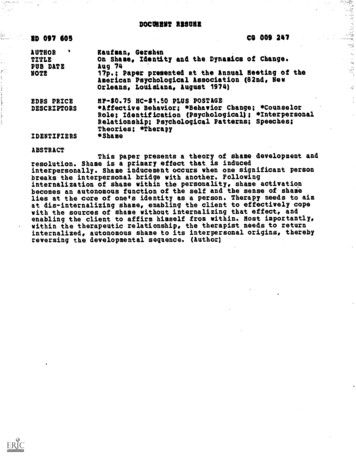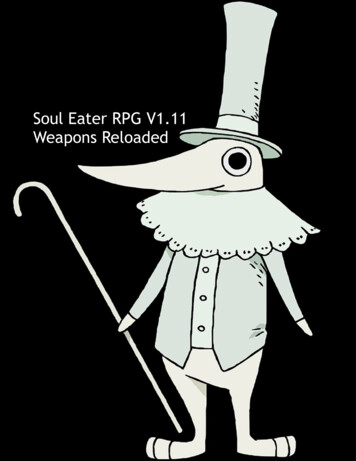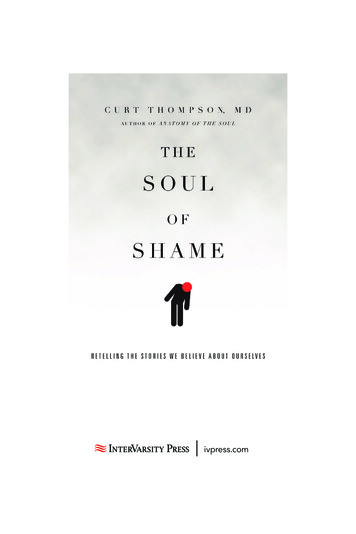
Transcription
ivpress.com
Taken from The Soul of Shame by Curt Thompson.Copyright 2015 by Curt Thompson. Published by InterVarsity Press,Downers Grove, IL. www.ivpress.com
IntroductionThe Story ThatShame Is Trying to TellThis is a book about shame. You might wonder why we need anotherbook about the topic. Shame has made an impressive resurgence in thepopular media as well as the academy. It has been the focus of helpful,impressive work by researchers such as Brené Brown and has become ago-to topic of conversation for talk shows. At one level this makes sense,given the place that shame has in our lives. For indeed, it is everywhere,and there is virtually nothing left untainted by it.From our family at home to the one at church. From the bedroom tothe boardroom. From school to work to play. From the art studio to thescience and technology lab. It is a primal emotional pigment that colorsthe images of everything: our bodies, our marriages and our politics;our successes and failures; our friends and enemies, especially the Godof the Bible, who may at times feel like both. It starts and (surprisingly)ends wars, only to start them again. It fuels injustice and creates ourexcuses for doing little if anything about it. It is a featured tool for motivating students, athletes and employees. It enables us to convenientlyremain separate from those we disagree with and who make us feeluncomfortable, while keeping to those who will only tell us what wewant to hear.And yet. Given the airplay it has received recently, one would thinkwe would have it all pretty much packaged and wrapped. We simply needSoulofShame.indd 95/18/17 12:13 PM
10The Sou l of Sh a meto do what we now know we can do to manage the problem. Is it reallyso complicated that we need yet another angle to approach it from?And yet. If the healing of shame were so straightforward, why are we stillso easily buckled by it? If you’re reading this, you may perceive faintawareness of shame’s place in your life, but perhaps you are intrigued because more and more people are talking about it. Or maybe you wrestle withshame rather frequently, seeing it or suspecting it in much of your life.Beyond this, you may be tormented by it or even feel wrangled to the groundby it; you would excise it from your life if you could. Its presence and activityare undeniable, as are your seemingly impotent tactics for addressing it.Despite all we know about shame, containing it, let alone disposing ofit, is a bit like grasping for mercury: the more pressure you use to seizeit, the more evasive it becomes. In my previous book, Anatomy of theSoul, I explored the intersection of Christian spiritual formation andfindings from the emerging field of interpersonal neurobiology. As Ihave had the privilege of walking with people in the context of that work,one theme continues to raise its head. No matter the setting, whether itis a retreat I am leading, a business with which I am consulting, a conference I am addressing or patients I am sitting with, shame eventuallymakes its way to center stage. Though unpleasant, its interpersonal neuro b iological effects are fascinating, while it simultaneously bends andtwists our narratives into painful story lines. It is ubiquitous, seeping intoevery nook and cranny of life. It is pernicious, infesting not just ourthoughts but our sensations, images, feelings and, of course, ultimatelyour behavior. It just doesn’t seem to go away.It is instructive to observe the way we respond to recent research thathas so helpfully awakened us to shame’s presence and the necessary placeof vulnerability in addressing it. Given the tidal wave of interest (as ofthis writing Brown’s TED talks have had over ten million views) onewould think that we were discovering shame for the first time in history.Indeed, even in the hallowed halls of psychoanalysis, shame has longremained in the shadows and has only in the last few decades been foundimportant enough for writers and clinicians to bring it into the light.But then again, haven’t we been here before? In 1988 John BradshawSoulofShame.indd 105/18/17 12:13 PM
The Story That Shame Is Trying to Tell11gave us Healing the Shame That Binds You and the PBS series that followed. It has helped literally millions of readers and viewers. You wouldthink, given this resource, that we would have made major gains in correcting our behavior as a culture and nation. But strikingly shame seemsto have effectively slinked into the shadows, only now again being ferreted out by a new wave of hunters. Apparently, we either forgot whatBradshaw and others were saying or never paid attention in the firstplace. It seems that virtually every generation has to go about the processof discovering shame again for the first time. This all reminds us that forall of our hope in cultural progression, in the deepest recesses of oursouls, we sense that that is an illusion.Upon reflection, perhaps this cycle is exactly what we should expectfrom shame. It likes to do its work and, when exposed, retreat into theshadows, only then to remerge no less potently than before. But it is alsopossible that the way shame operates is an extension of something largerand more sinister. And to realize this is also to realize that the healing ofshame is not merely going to be a function of greater social awareness ofit or a novel mental health exercise. To effectively enter into the healingof shame requires us to know the place it holds in our story as a humanrace, and that requires us to know which story, exactly, we believe we areliving in. This book, therefore, is not just a book about shame. It is a bookabout storytelling—the stories we tell about ourselves (which of courseinclude others and especially God), how we tell them and, more importantly, the story that shame is trying to tell about us.Our Story and Shame’s StoryOf all the things that set us apart from the rest of creation as humans, onefeature stands out: we tell stories. No other creatures we know of tellstories the way we do. (Well, it’s possible that certain plants and animalstell stories. They’re just not telling us.) Whether we know it or not, andwhether we intend to or not, we live our lives telling stories; in fact, wedon’t really know how to function and not tell them. We tell them formany reasons. We do so not just to describe what we are doing but tomake sense of what we have done. Some may be familiar with the ideaSoulofShame.indd 115/18/17 12:13 PM
12The Sou l of Sh a meof our having a narrator that is infrequently quiet, informing us of thelife we are living, and not always using only words. Each of us lives withina story we believe we occupy. Not all of us are equally conscious of this.Depending on which story we believe is the big story, the one that unitesall the other stories and is the real story about the world, shame will beunderstood and dealt with accordingly.In this book I will examine shame in the context of the biblical narrative. And, as I will suggest more directly later, if shame is not understood in this context, it will become a powerful driving force in telling adifferent story. There are alternatives to the biblical story that considershame differently than we will in this book. For example, it can be comprehended within some version of a naturalistic evolutionary framework,but for my money that story has very little drama and no purpose. It goesnowhere. It ends with the earth and humanity either flaming out orfreezing up, and we are left to make up our own existential meaningwhile we wait for the end to come. If that’s the story we’re living in, shamemight be an interesting topic for a discussion, but for the most part itsimply plays the role of emotional nausea.But what if shame is embedded in a story that does have purpose?Even more troubling, what if it is being actively leveraged by the personality of evil to bend us toward sin?Typically, whenever researchers study and discuss shame, we do so asthough it is some abstract emotional or cognitive phenomena. We describe shame as something we would do well to better regulate, but not asan entity that has a conscious will of its own. But I believe we live in a worldin which good and evil are not just events that happen to us but ratherexpressions of something or someone whose intention is for good or forevil. And I will suggest that shame is used with this intention to dismantleus as individuals and communities, and destroy all of God’s creation. Youmay not agree, but even so I believe this book will still be helpful for you.This, then, is a book about the story of shame. The one we tell about it,the one it tells about us, and even more so the one God has been tellingabout all of us from the beginning. Most important, this book also examines how the story of the Bible offers us a way not only to understandSoulofShame.indd 125/18/17 12:13 PM
The Story That Shame Is Trying to Tell13shame but also to effectively put it to death, even if that takes a lifetime toaccomplish. But putting shame to death is not simply about addressing itas a deeply destructive emotional and relational nuisance. For we cannotspeak of shame without speaking of creation and God’s intention for it.From the beginning it has been God’s purpose for this world to be one ofemerging goodness, beauty and joy. Evil has wielded shame as a primaryweapon to see to it that that world never happens. Consequently, to combatshame is not merely to wrestle against something we detest. It is to do thatvery thing that provides the necessary space for each of us to live like God,become like Jesus and grow up to be who we were born to be.The premise of this book, then, is that shame is not just a consequenceof something our first parents did in the Garden of Eden. It is the emotional weapon that evil uses to (1) corrupt our relationships with God andeach other, and (2) disintegrate any and all gifts of vocational vision andcreativity. These gifts include any area of endeavor that promotes goodness,beauty and joy in and for the lives of others, whether that be teaching ourfirst graders, loving our spouse well, managing forests, conducting healingprayer services, creating a new medical technology, offering psychotherapyor composing symphonies. Shame is a primary means to prevent us fromusing the gifts we have been given. And those gifts enable us to flourish asa light-bearing community of Jesus followers who work to create space forothers who wish to join it to do so. Shame, therefore, is not simply anunfortunate, random, emotional event that came with us out of the primordial evolutionary soup. It is both a source and result of evil’s activeassault on God’s creation, and a way for evil to try to hold out until the newheaven and earth appear at the consummation of history.However, while this book holds shame to be within the context of agrand story, and so takes on its place and meaning, within that story’spurpose lie the mechanics of how shame works. Familiarity with thosemechanisms, through the lens of interpersonal neurobiology, though notsubstantiating shame’s teleology, can open up ways for us to align ourselves with the purpose that God has for a world in which mercy andjustice reign, a world teeming with goodness and beauty, and in whichjoy of true relationship is our destiny.SoulofShame.indd 135/18/17 12:13 PM
14The Sou l of Sh a meA Tale of What Is AheadToward that end, this book approaches our topic as follows. In chapter oneI will establish a working description of shame and what we assume it tomean for our purposes. I will describe how we generally experience it andwhat its nature tends to be in everyday life. Chapters two and three engageour quarry from an interpersonal neurobiological (IPNB) approach. Wewill take a tour of what the mind is and what it means to flourish from anIPNB perspective, followed by an introduction to how shame operates asa disintegrating force within the mind, relationships and communities.This sets the stage for chapter four, which reminds us that at our core weare storytelling creatures. To know your story is to know shame’s place in it.Here we will explore some features of stories in general, how we tell themand the value of knowing which story you believe you are living in. We willsee shame’s potential both as cause and effect of the stories we construct.Chapter five invites us specifically into the biblical narrative, offering oneway of considering shame in light of the story that followers of Jesus believethey occupy. We consider how in the Genesis account of creation, shame isfeatured as something that evil has been wielding from the very beginningto corrupt God’s intended creation of goodness and beauty.Chapter six introduces us to the fulcrum on which the healing ofshame hangs in the balance. We will discuss the deep reality of what itmeans that (1) we are relational and therefore necessarily vulnerablebeings, and (2) the healing of shame begins and ends in the experienceof being known, a biblical notion that begins in the heart of God, is offered to humans in Genesis, and reaches its culmination on Good Friday.Healing shame requires our being vulnerable with other people in embodied actions. There is no other way, but shame will, as we will see,attempt to convince us otherwise.Chapter seven offers a model for what it means to directly address shamein concrete ways. Passages from the epistle to the Hebrews and the Gospelof John will serve as guides for implementing the requirements necessaryfor us to not only heal shame but to begin to see how its redemption leadsto greater relational integration and opportunity for creative endeavor.Chapter eight then extends the path of what we learn in chapter seven intoSoulofShame.indd 145/18/17 12:13 PM
The Story That Shame Is Trying to Tell15the primary communities in which we are nurtured: our family, the churchand our educational institutions. We will see how these realms have theirparticular ways of incubating shame, and what we can explicitly do to re imagine our stories in these most formative of settings.This brings us to the book’s culmination in chapter nine, in which wewill explore how shame’s healing leads to renewed vitality in the multipleways God has called us. For in our deliverance from shame we are notsimply liberated to be nicer, happier people; rather, we are redeemed tolive into those multiple roles of calling—from parenting to teaching toengineering—with joyful creativity.Reading this book will require varying degrees of effort, for any numberof reasons. Combating shame requires more work than you mightimagine. I say this not because I am in any way impressed with what iswritten here or how it has been said; it’s not as if the ideas are original tome, for they certainly aren’t. Nor do I say it because I have slain all mydragons of shame—far from it. Rather, it is just the opposite. I am deeplyaware of how difficult it is to directly confront this problem. I am livingproof of this. In fact, the very act of writing this book has revealed morespaces within my inner life that shame inhabits than I would like to admit.The process has activated a whole host of feelings that include fears ofinadequacy, worries that I will not be clear or correct or effective, concerns that whatever I may have to say, someone else could say it better,more simply and certainly not require the reader to work so hard to getthrough all the ink on the paper. I didn’t expect that writing a book onshame would be the very thing that revealed just how deeply rootedshame is in me. But frankly, if putting shame to death requires this muchhard work, I would rather have folks along for the journey who are willingto do the same, reminding me that I am not alone in the process.A Few CaveatsIn this book I do not address the distinctives that pertain to shame cultures, shame-honor cultures or shame societies vis-à-vis guilt cultures.Much has been published on these topics, and they are not unhelpful inproviding a window through which we can understand societal behavior.SoulofShame.indd 155/18/17 12:13 PM
16The Sou l of Sh a meSuffice it to say, however we choose to talk about cultures as a whole, eachone has its own particular way of manifesting shame and guilt. Thesewords symbolize human experience that is universal, although certainlythe socialization of these fundamental emotional states is bound to shapehow we interpret them. These categories of shame-honor and guilt cultures do not imply, either, that shame cultures do not know about or experience the phenomenon of guilt, or that guilt cultures do not experience shame. In this book we are exploring shame not as a sociallyconstructed finding but rather an interpersonal neurobiological event.This is not to say that what you find here is the last word on shame or theonly or even the best way to comprehend it. Rather, this is hopefully oneway to approach it such that we may live more fully integrated lives.On another front, I do not address to what degree shame is a goodthing, something that we require in society to ensure that people willbehave appropriately. In this book I am not debating this question, norin any way suggesting that all shame experience is necessarily bad.Indeed, it is reasonable to assume that shame as an interpersonal neurobiological process plays a necessary role in helping us develop properself-regulatory behavior. However, it is equally true that many behaviorsthat are not deterred (but that we believe should be) emerge from established shame-based patterns of life that precede said behaviors. It isbeyond the scope of this book to explore every aspect of our topic. Myintention here is to address those universal experiences of shame thatlead to disintegrated states of mind that end in disintegrated communities with little creative capacity for goodness and beauty.Still, questions may remain. Exploring in the way I propose, might wenot run the risk of dismissing the necessary, helpful aspects of shame tooeasily? Without it, won’t we devolve into madness? Moreover, is there nota clear difference between the shame felt by a woman who commitsadultery and a woman who is raped?Although these are not unimportant questions, they are not theprimary subject of our inquiry, nor is there space in this volume to address all of the questions that our topic invariably raises. However, aworld in which shame did not exist would also be one in which thoseSoulofShame.indd 165/18/17 12:13 PM
The Story That Shame Is Trying to Tell17very behaviors we fear would be unleashed would not likely exist either,given how many of them emerge out of shame in the first place. And, yes,the story of an adulteress is quite different from that of a rape victim. Butthe shame that the victim of sexual assault feels is often no more easilyhealed than that of a woman involved in an affair “simply” because theformer “knows” her shame was not a result of her actions. For indeedshame’s power lies not so much in facts that we can clarify but rather inits emotional state, which is so much harder to shake.Throughout this book you will read the stories of people like you andme who are wrestling with shame and doing their best to fix their eyeson Jesus, do what he did and despise it on the way to being liberated tocreate as they were so intended from the beginning. No matter if you areone who is simply curious about shame or find yourself buried underneath it, I believe this book can offer help and hope.I acknowledged earlier that you may be either unfamiliar with or donot believe the story the Bible tells. Well, you’re in good company. Thereare many days that I have a hard time believing it myself. The very natureof the world is such that at times it takes near Herculean effort to maintainthe conviction that Jesus is real, that God is truly loving and that we areat war with evil. This book, therefore, is no proof text about anything. Itis, rather, an invitation to be known, to be loved (whether you believe inGod or not), but also to join me and others to risk all you have on a Godwho would rather die than let anything come between us all. As you readthis invitation, then, you may find some practical help for dealing withshame (especially as you apply the elements of IPNB), even if the big storyof the Bible doesn’t yet feel comfortable enough to try on. At the very leastI’ll be glad to know that in having read this book you have found yourselfto be drawn into relationships that are more joyful and intimate, engagedin work that is more meaningful and creative, and casting a vision forseeing goodness and beauty where perhaps before you did not.At the book’s conclusion you will find questions associated with eachchapter for further discussion. Shame is not something we “fix” in theprivacy of our mental processes; evil would love for us to believe that tobe so. We combat it within the context of conversation, prayer and otherSoulofShame.indd 175/18/17 12:13 PM
18The Sou l of Sh a mecommunal, embodied actions. Therefore I encourage you to use thequestions not only for your own personal use but also for engaging oneanother as a means of healing in real time and space.With these thoughts in mind, I invite you to join me in discoveringthe soul of shame, the story it is trying to tell and the alternative story ofgoodness and beauty that God is telling, one that God is imagining forus all, one in which he is doing “immeasurably more than all we ask orimagine, according to his power that is at work within us.”SoulofShame.indd 185/18/17 12:13 PM
Our Problem with ShameNo, I’m not willing to do that.” He was succinct and clear. I inquiredwhat he felt as he imagined telling his wife about the affair. “Terrified.”Of what, I asked? He could only describe in vague terms the abject senseof humiliation he would have to endure should this illicit relationshipcome to light.She was the chief executive of a successful marketing firm and had reliedon her hard-driving style to get things done. She was bewildered that hercompany was listing, and her effort to work harder was not effectivelyrighting the ship. She was running out of ideas. I inquired as to whomshe could ask for help. Without hesitation she informed me that to admitshe needed assistance was tantamount to resigning. “I can’t afford not tohave ideas that work. If I have to ask for help, I will be seen as incompetent and the board will fire me.”“She didn’t get in, and I’m worried about what this will mean for herfuture.” This, coming from a mother who had worked diligently to do herpart to help her daughter gain entrance to her top school choice. Thismight be understandable, except for the fact that her daughter was onlythree years old.SoulofShame.indd 195/18/17 12:13 PM
20The Sou l of Sh a meWhy had no one protected her? By the time she was twenty-six she hadslept with over fifteen men and endured two abortions. But the sex hadbegun when she was eleven, with an uncle who had first treated her asspecial, but eventually threatened her very life if she were to reveal thehorror. This lasted until she was seventeen, when she left for college,where she was free of her uncle but imprisoned to the behavior that wasthe only path she knew to “intimacy” with a man. How in the world wasshe to tell her parents, let alone friends or anyone in her faith community? The only reason she was telling me was that her depression hadbecome too overwhelming for her to function.The hypothesis had finally been proven. The elegant biochemistry, thecomplex statistical analysis of the patients’ clinical responses to the drug,and a little luck had all added up. All the work, all the long hours awayfrom his family, all the grant money spent—it was all finally worth it.Along with this discovery would certainly come the offer of a tenuredposition he had long coveted and that the university would be unable todeny him. Not to mention the potential earnings once the patent camethrough. There was only one problem. An ethics board that was taskedto make sure his lab’s research was beyond reproach had found somequestionable data reporting. And before the week was over, his life wasunraveling faster than he could have imagined, the result of someone’sneed to make history fighting cancer.He began drinking when he was thirteen. He had two DUIs by the timehe was twenty, the second one landing him in jail for a month. That wasmore than two decades ago, before he met Jesus. But in the last five yearsthe bourbon had begun to flow again most evenings after everyone wentto bed. His wife had informed him that if the drinking didn’t stop, shewas leaving and taking the children with her. Then there was the issue ofhis work. How, exactly, would he tell the people of his congregationwhere he had been the pastor for fifteen years? Jim Beam seemed to beSoulofShame.indd 205/18/17 12:13 PM
Our Problem with Shame21the only thing that helped him hang on in the face of the burnout he feltshepherding such a challenging flock.Our Stories of ShameStories. Each of us has one, and at some point the people in the previousscenarios sat in my office telling me his or hers. And theirs are just the tipof the iceberg. There are many more, each with different screenplays, eachthat emerges from a different family of origin, each with its own particularjoys and sorrows, victories and defeats. No matter what initially bringsthem to see me, their stories eventually lead to the moment when what Ibelieve to be the lowest common denominator in human relationshipsmakes its way into the room. It matters not if the person earns a twocomma salary or works for minimum wage. She may be married or single.He may be African American or Caucasian. Depressed, anxious or justplain angry; happy, sad or indifferent. He may be the father or the son, theemployer or employee. It may be an individual, a couple, family, community, school or business organization. And you needn’t have everdarkened the office door of a psychiatrist. It doesn’t require the breakdownof our mental health to be plagued with it. It only requires that you have apulse. To be human is to be infected with this phenomenon we call shame.Shame is something we all experience at some level, more consciouslyfor some than for others. Of course there are the obvious examples thatcome to mind: times we have felt everything from slight embarrassmentto deep humiliation. The tabloids are rife with cover stories of the latestfollies of celebrities or politicians who have behaved badly. But many ofus carry shame less publicly, often outside the easy view of even some ofour closest friends. Unemployment. Having a family member whose alcoholism is displayed in front of your friends. Losing a major account atwork. The breakup of a marriage. Our child’s seeming disinterest inschool. A boss whose motivational tactic is to regularly compare yourwork to that of someone else who is outperforming you. Any of thesemore common scenarios carry the burden of shame in ways that we workhard to cover up. And our coping strategies have become so automaticthat we may be completely unaware of its presence and activity.SoulofShame.indd 215/18/17 12:13 PM
22The Sou l of Sh a meShame can vary in its range from the most relationally subtle ways—thecondescending glance or tone of voice from one spouse to another—towholesale cultural movements that involve groups, communities and eventually nations that war against nations—the biblical story of Dinah inGenesis 34, racial bigotry and suppression, or the murder of a woman forhaving publicly shamed her family, known commonly in some cultures asan honor killing. It is therefore not merely a function of the things I thinkor say about myself or others, nor is it limited to what happens between twoindividuals. It can move stealthily from the bedroom or kitchen to theplaying field to the boardroom to the Situation Room, where decisions aremade on a global scale. In this way, even the slightest shaming interactionsbetween individuals can eventually grow into conflagrations that involvemultiple parties. Longstanding conflicts such as those in the Middle East orEast Los Angeles are evidence that when individuals do not address theshame they experience at a personal level, the potential kindling effect caneventually engulf whole regions of humanity. One of the purposes of thisbook is to emphasize that what we do with shame on an individual level haspotentially geometric consequences for any of the social systems we occupy,be that our family, place of employment, church or larger community.It is also important at the outset of this book to note that I do notconsider this infestation to be neutral or benign. This is not merely a feltemotion that eventually morphs into words such as “I’m bad.” As I willsuggest, this phenomenon is the primary tool that evil leverages, out ofwhich emerges everything that we would call sin. As such, it is actively,intentionally, at work both within and between individuals. Its goal is todisintegrate any and every system it targets, be that one’s personal story,a family, marriage, friendship, church, school, community, business orpolitical system. Its power lies in its subtlety and its silence, and it willnot be satisfied until all hell breaks loose. Literally.Over the last ten years I have been privileged to walk with people asthey have been courageously engaging their stories, moving to places ofgreater depth and connection with God and others while applying newinsights that have emerged from the field of interpersonal neurobiology,which I explore in Anatomy of the Soul. They have learned about variousSoulofShame.indd 225/18/17 12:13 PM
Our Problem with Shame23domains of the mind and what it means to love God and others with allof it. They have realized what it means to pay attention to what they payattention to; the overarching role of emotion in human activity; howmemory is as much about predicting
The Story That Shame Is Trying to Tell 11 gave us Healing the Shame That Binds You and the PBS series that fol-lowed. It has helped literally millions of readers and viewers. You would think, given this resource, that we would have made major gains in cor-recting our behavior as a cultur

